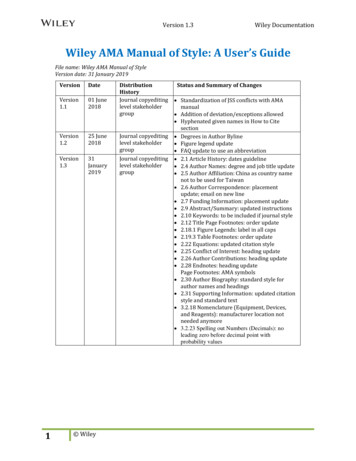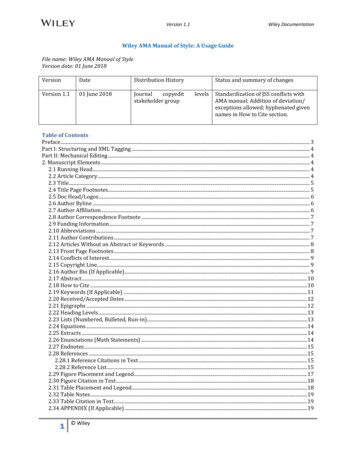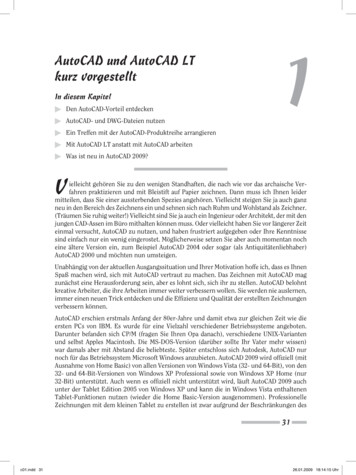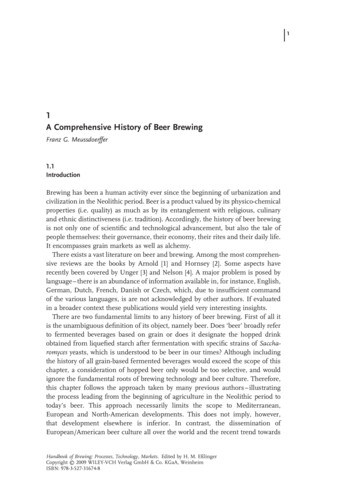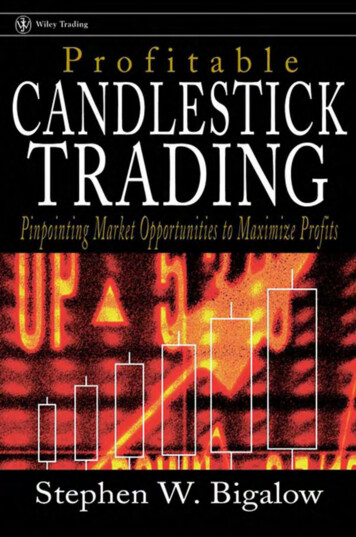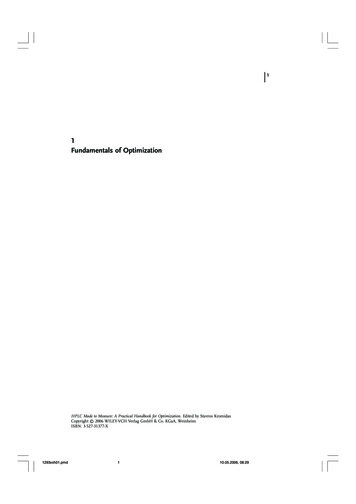
Transcription
11Fundamentals of OptimizationHPLC Made to Measure: A Practical Handbook for Optimization. Edited by Stavros KromidasCopyright 2006 WILEY-VCH Verlag GmbH & Co. KGaA, WeinheimISBN: 3-527-31377-X1293vch01.pmd110.05.2006, 08:29
1293vch01.pmd210.05.2006, 08:29
31.1Principles of the Optimization of HPLC Illustrated by RP-ChromatographyStavros KromidasFirst of all, some questions will be discussed, which should reasonably be answeredbefore beginning method development. Subsequently, we will treat the principalpossibilities for improving the resolution in HPLC. It follows a discussion aboutefficiency and the “right” sequence of such measures for the isocratic and thegradient mode. There is a particular focus on strategies and concepts for developinga method and checking peak homogeneity.The last section will show ways to achieve other aims than “better separation”:“make it faster”, “raise sensitivity” or “save money”. The chapter ends with aconclusion and an outlook.1.1.1Before the First Steps of OptimizationFor economic reasons, one really ought to address the following questions priorto commencing the development of a method or the optimization of a givenseparation. What do I want? In other words, what is the true intention of the separation? What do I have? That is to say, what relevant information about the analyticalpurpose and the samples is available? How should I do it? Do I have all what I need, and is what I want to do reallypossible?At first glance, these questions might appear too theoretical or even over-critical.Nevertheless, careful consideration of the actual aims and realistic possibilitiesfor solving an analytical problem would seem to be important at the outset. Anearly discussion with my boss, a colleague or my client – if you are short, evenwith yourself – can later prevent a good deal of trouble, time expenditure, and lastbut not least costs. This time-saving can be considered a good investment.As regards the first question: “What do I want?”If it is at all possible, at the outset the following or similar questions should beanswered: Do I need a method for the accurate quantification of this toxic metabolite, or isthe aim that the authorities just accept my method? What is most important in this case: short analysis times, durable columns,robust conditions, or simply optimal specificity? Must the relative standard deviation Srel be no higher than 2%? What loss of qua-lity would be incurred if Srel were to be 2.5%? Is there actually a correlation between the cost of the analysis and real improvement in the quality of the product?HPLC Made to Measure: A Practical Handbook for Optimization. Edited by Stavros KromidasCopyright 2006 WILEY-VCH Verlag GmbH & Co. KGaA, WeinheimISBN: 3-527-31377-X1293vch01.pmd310.05.2006, 08:29
41 Fundamentals of OptimizationIn other words, is the aim just to meet the requirements in this specific case or isthe real “truth” at stake, i.e., are formal aspects or analytical questions in theforeground? This question should be consciously and truthfully answered becauseof the possible consequences.How difficult it can be to stand by meaningful and well-considered decisionswithout being regarded as outlandish or as a troublemaker has been documentedelsewhere [1]. Where possible, one should question all aspects. Unconventionalquestions frequently result in simple solutions.As regards the second question: “What do I have?”Information on the sample makes the design of a suitable method easier.Some examples: What is written in the report of colleagues from the chemical development department on the light sensitivity and the sorption properties on glass surfacesof a new drug?Can I contact these colleagues quickly? That is to say, can I get relevantinformation with a minimum of effort?There may be information about similar separations in the past, which werenot pursued further, in an internal database (which is perhaps rarely updatedand even more rarely accessed).May I quickly calculate the pKa value of the known main component in thesample with appropriate software (see Chapter 1.4)?Has a colleague in a neighboring department worked in the past with similarcompounds and might therefore be able to provide valuable insights?As far as possible, all means of communication with colleagues should be pursuedto gather information. At times it may be helpful not to make this public.As regards the third question: “How should I do it?”One should assess the feasibility of the proposed work absolutely unconditionally.Some examples: Can I convince my boss that it is useful from the overall company point of viewto discuss in advance with the later routine users the design of the method andadditional details? If fear of loss of know-how or questions of budget or otherpsychological and social barriers make impossible de facto a discussion with“the others”, it is a bitter reality that one must accept. On the other hand, is it worth fighting for a change of the following well-knownand accepted situation? A deadline is fixed and therefore a validation must befinished in two weeks. Later, the burden of subsequent, substantial costs for arepeat of the measurements, complaints, out-of-spec situations, etc., whichinevitably result because an analytical method can hardly be validated withintwo weeks under real conditions, is not placed on “us” but on quality control,and as testing costs they have been accepted since decades in the absence ofoverall considerations. The reader may imagine the consequences, or viewedmore positively, the possibilities for improvement.1293vch01.pmd410.05.2006, 08:29
1.1 Principles of the Optimization of HPLC Illustrated by RP-Chromatography Is it really worthwhile in the case of the development of a routine method,which shall be applied all over the world, to opt for a polar RP-phase because ofthe frequently observed higher selectivity, even if one has to expect problemswith the charge-to-charge reproducibility? Might a hydrophobic, more ruggedcolumn with a lower but still sufficient selectivity the better choice? Is it useful to demonstrate my analytical “knowledge” by further trimming therelative standard deviation of a method being used in diverse plant laboratoriesto a value of 0.7%?Realities – and opinions are also realities – which determine the success or failureof an analytical activity should, wherever possible, influence the design of themethod. It is useful if the number of meetings can be reduced to “a cup of coffee”or “lunch often together”. The point is to improve the communication and thiscan turn out to be easier in a less formal situation.In conclusion, two basic preconditions for successful method development maybe noted:1. Expert knowledge exists or can be loaned or sold.2. The analytical possibilities correspond with the requirements, and it is possibleto talk about them.In the author’s opinion, a clear definition of requirements, unequivocally formulated, understandable goals for all involved persons, shortcuts to information, anda critical estimation of possibilities/risks are more important, not only in analytics,than obtaining exemplary results such as low detection limit, correlation factorsaround 0.999, Srel smaller than 1%, or 30% less expensive equipment.1.1.2What Exactly Do We Mean By “Optimization”?Optimization of a separation is principally directed by the following goals: to separate better (higher resolution),to separate faster (shorter retention time),to see more (lower detection limit),to separate at lower cost (economic effort),to separate more (higher throughput).The three first-named goals may be most important, and of these the improvementof the resolution is the prime concern. Therefore, we will treat this topic beforewe start to deal with the other aspects. Preparative HPLC is not the subject of thisbook.Preliminary RemarksThe theory of chromatography is fundamentally valid for all chromatogaphictechniques. Therefore, basically the same principles are pursued. However, it is1293vch01.pmd510.05.2006, 08:295
61 Fundamentals of Optimizationevident that the priorities and the weighting of the specific steps are very different,for example in GPC and in μ-LC-MS(MS). In the following, the possibilities foroptimization are presented and proposals for the most popular liquid-chromatographic technique, RP-HPLC, are given in short form.The characteristics of the different modes are treated in Chapters 2.1 to 2.7. Itis assumed that the reader is familiar with the chromatographic rules and thetheory of HPLC, so these are not treated in detail, but where necessary sometechnical terms are briefly explained.The immediately following remarks relate to isocratic separations.1.1.3Improvement of Resolution (“Separate Better”)Resolution (R), in simplest terms, is the distance between two neighboring peaksat the base of the peaks. An increase in this distance is what every chromatographerroutinely strives for.The corresponding equation is:R 14N k2α 1 αk2 1where N is the plate number, a measure of the performance or the efficiency ofthe column.The number of plates is in effect a measure of the widening of the substanceband because of diffusion effects. The basic question is whether the molecules ofthe analyte that reach the detector are contained in a small or a large (peak) volume,i.e., will one get sharp or broad peaks?Strictly speaking, one should distinguish between the theoretical and theeffective plate number. The theoretical plate number is the number of plates ofan inert component (see below) and therefore a characteristic and constant valuefor a column under defined conditions. The effective plate number is the numberof plates of a specified retained component, and the retention factor (see below)enters into the calculation. Today, however, this distinction is not made everytime;one speaks only about plate number. In the most cases, the theoretical platenumber is calculated, but of retained substances. In this context, it should bemade clear that the plate number depends on a lot of factors, e.g. the injectionvolume, the temperature, the composition of the eluent, the flow rate, theretention time, the analyte, and last but not least the equation used for thecalculation, i.e. peak width at the peak base, at 10% or at 50% peak height.Therefore, the comparison of literature values of plate numbers is inherentlydifficult.α: Separation factor, formerly selectivity factor.α is a measure of the capability of a chromatographic system (chromatographicsystem: the actual combination of the stationary phase, the mobile phase, and thetemperature) to distinguish two given compounds.1293vch01.pmd610.05.2006, 08:29
1.1 Principles of the Optimization of HPLC Illustrated by RP-ChromatographyThe α value is the quotient of two net retention times, i.e. the quotient of thedwell times of the two components within the stationary phase.The point is that if this particular chromatographic system is selective for thesetwo compounds, then in principle they are separable. Selectivity, in simplest terms,is the distance between two peaks, from the top of one peak to the top of theother. This is different from the resolution in that for the determination of theselectivity the form of the peak (plate number) is not considered, because α isonly the quotient of two (retention) times. The separation factor depends only onthe chemistry; see below on the subject of retention factor.k: Retention factor, formerly capacity factor k′.k is a measure of the strength of the interaction of a given compound in a givenchromatographic system. It expresses for how much longer a given compoundremains on the stationary phase compared to the mobile phase.The k value is an index like the α value, and is thus independent of instrumentalconditions such as the dimensions of the column or the flow rate. The k valuechanges only if parameters that have something to do with the interaction arechanged, i.e., the chemistry: stationary phase, mobile phase, temperature. As longas these parameters are kept constant, the k value also stays constant, irrespective,e.g., of the flow rate or whether a 10 or 15 cm column is used.Although the dead time does not appear explicitly in the equation for the resolution,it is useful for the following explanation to briefly deal with this term.tm: dead time, breakthrough time, front, “air peak”: This is the dwell duration of aninert component in the HPLC equipment. A component is designated as inert ifit is able to penetrate everywhere without steric hindrance, including, of course,in the pores of the stationary phase, but is not retained there. In other words, thedead time is the time of the presence of any not excluded component in the mobilephase – also in the standing mobile phase (i.e., within the pores), but again thereis “no” interaction with the stationary phase. Therefore, the dead time only changesif something “physically” or “mechanically” is altered, e.g. a change in the lengthor the inner diameter of the column, the packing density, or the flow rate. The deadtime is a time, which is independent from the particular compound just analysed.As all components move equally quickly in the eluent, the time that the compoundsspend in the eluent makes no contribution to the separation. A separation is onlypossible if the substances stay in the stationary phase for different lengths of time.The resolution R – the distance from peak base to peak base – depends only onthe following three factors: the strength of the interaction between the compound and the stationary phase(if the peak comes soon or late), i.e. on the k value, the ability of the chromatographic system to distinguish between the twocomponents of interest, i.e. the α value, if the relevant peaks are sharp or wide, i.e., the plate number.1293vch01.pmd710.05.2006, 08:297
81 Fundamentals of OptimizationConsequently, to improve resolution, there are in principle only three po
column with a lower but still sufficient selectivity the better choice? . RP-HPLC, are given in short form. The characteristics of the different modes are treated in Chapters 2.1 to 2.7. It is assumed that the reader is familiar with the chromatographic rules and the theory of HPLC, so these are not treated in detail, but where necessary some technical terms are briefly explained. The .

